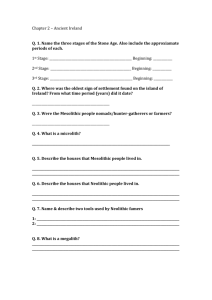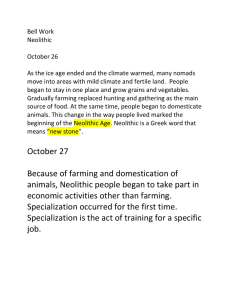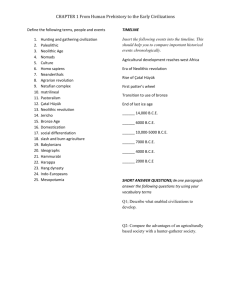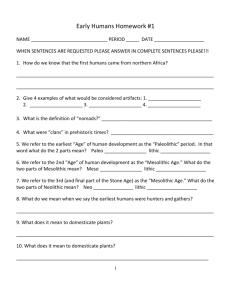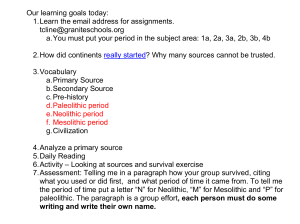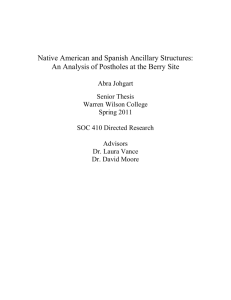what - Archaeological Research Services Ltd
advertisement
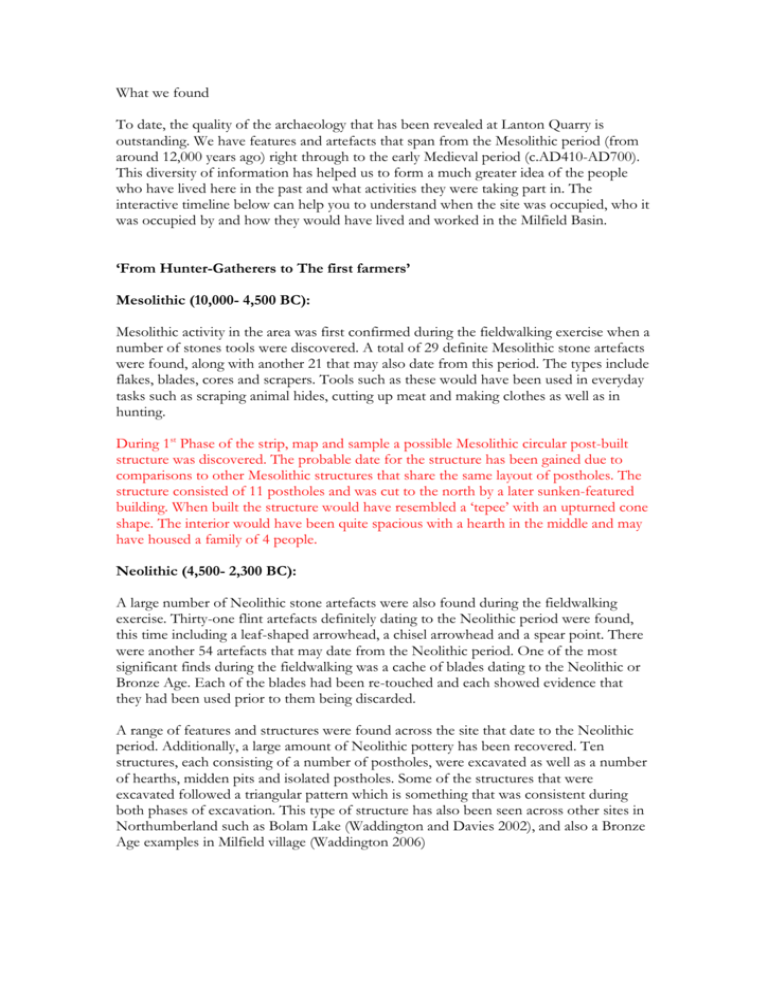
What we found To date, the quality of the archaeology that has been revealed at Lanton Quarry is outstanding. We have features and artefacts that span from the Mesolithic period (from around 12,000 years ago) right through to the early Medieval period (c.AD410-AD700). This diversity of information has helped us to form a much greater idea of the people who have lived here in the past and what activities they were taking part in. The interactive timeline below can help you to understand when the site was occupied, who it was occupied by and how they would have lived and worked in the Milfield Basin. ‘From Hunter-Gatherers to The first farmers’ Mesolithic (10,000- 4,500 BC): Mesolithic activity in the area was first confirmed during the fieldwalking exercise when a number of stones tools were discovered. A total of 29 definite Mesolithic stone artefacts were found, along with another 21 that may also date from this period. The types include flakes, blades, cores and scrapers. Tools such as these would have been used in everyday tasks such as scraping animal hides, cutting up meat and making clothes as well as in hunting. During 1st Phase of the strip, map and sample a possible Mesolithic circular post-built structure was discovered. The probable date for the structure has been gained due to comparisons to other Mesolithic structures that share the same layout of postholes. The structure consisted of 11 postholes and was cut to the north by a later sunken-featured building. When built the structure would have resembled a ‘tepee’ with an upturned cone shape. The interior would have been quite spacious with a hearth in the middle and may have housed a family of 4 people. Neolithic (4,500- 2,300 BC): A large number of Neolithic stone artefacts were also found during the fieldwalking exercise. Thirty-one flint artefacts definitely dating to the Neolithic period were found, this time including a leaf-shaped arrowhead, a chisel arrowhead and a spear point. There were another 54 artefacts that may date from the Neolithic period. One of the most significant finds during the fieldwalking was a cache of blades dating to the Neolithic or Bronze Age. Each of the blades had been re-touched and each showed evidence that they had been used prior to them being discarded. A range of features and structures were found across the site that date to the Neolithic period. Additionally, a large amount of Neolithic pottery has been recovered. Ten structures, each consisting of a number of postholes, were excavated as well as a number of hearths, midden pits and isolated postholes. Some of the structures that were excavated followed a triangular pattern which is something that was consistent during both phases of excavation. This type of structure has also been seen across other sites in Northumberland such as Bolam Lake (Waddington and Davies 2002), and also a Bronze Age examples in Milfield village (Waddington 2006) ‘The age of metal’ Bronze Age (2,300- 700 BC): During the fieldwalking exercise some stone artefacts dating from the Bronze Age were discovered. A barbed and tanged arrowhead was found along with 38 other artefacts which may also date from this period. These include scrapers and flakes. Although metal was introduced into Britain during this period, stone tools were still very much part of daily life and this continued to be the case for long after the introduction of metal. Two round houses that were excavated on site have been identified as possibly dating from the Bronze Age. Both consisted of a number of postholes arranged in a circular pattern with more postholes forming a ‘porch’. In both cases the porch entrance faced south-east, a pattern which has been noted elsewhere on other examples. As well as circular structures, there are some rectangular structures that date from the Bronze Age. These structures usually comprise 6 postholes, however one of the structures at Lanton consisted of 9. It is thought that the additional 3 postholes were added after the main construction as structural repairs. Pottery dating from the Bronze Age period was quite common across the site and in many cases helped to date the features in which it was found. Iron Age (700BC- AD43): While the amount of Iron Age archaeology that was found was relatively small compared to that from some of the other time periods, it was perhaps the most exciting. During the 1st Phase of excavations in 2006, a round house was excavated that is thought to have belonged to the Iron Age period. The structure comprised 8 postholes and measured 8m internally. The diameter of the structure indicates that it is Iron Age due to the fact that few Bronze Age circular structures are so large. During the 2nd Phase of the work, two corbelled stone built cists were discovered and excavated. Burial cists are usually associated with the Bronze Age and are constructed using flat stones. However, the cists at Lanton Quarry were constructed in a completely different way (see images). The better constructed of the two cists was found to contain human remains. A skull and parts of the leg bones of a 34-75 year old female were discovered on the base of the cist. Radiocarbon dates show that the woman may have died sometime around 50BC, which would mean that she was alive during the Iron Age. Of particular interest about this female is the fact that she may have been around 60 years of age. During the Iron Age living to this age was quite rare. There is also evidence that the woman was suffering from a form of arthritis. It would seem that whoever the woman was, she would have been looked after well to have reached such an old age, especially with a joint disease. Perhaps this could mean that she was of high status amongst her community. ‘Living in the shadow of an Anglo-Saxon palace’ Anglo-Saxon/Early Medieval (AD400-700): The majority of Anglo-Saxon activity at Lanton was situated in the southern end of the site forming a village. Before the Anglo-Saxon period, structures usually all consisted of postholes arranged in a number of different ways. However, the Anglo-Saxons often constructed sunken-featured buildings. These structures consisted of a shallow rectangular pit with a flat base and a posthole at either end. Seven of these types of structures were found in total. One of these features produced some fragments of loom weight. It also had a clay floor in the northern end including some clay posts suggesting where the loom may have been situated. Also recovered from the sunken buildings were some ceramic sherds, some metal fragments, slag, glass slag, clay, a glass bead and animal bone fragments. All of these materials indicate that a wide range of industrial activities were being carried out on the site. As well as the sunken featured buildings were those constructed with posts arranged in a rectangular pattern. Four of these types of structure were excavated at Lanton Quarry. Most of the postholes were of a substantial size, indicating that they would have held large posts. Compared to the sunken buildings, the post-built structure produced very little industrial material. This would suggest that the sunken featured buildings were primarily used for industrial purposes.
